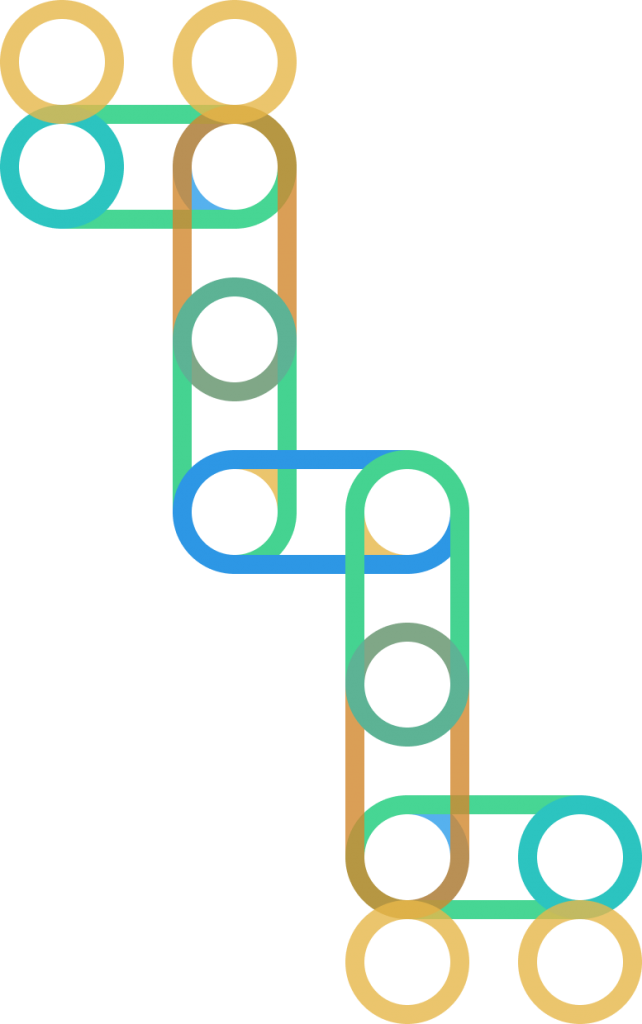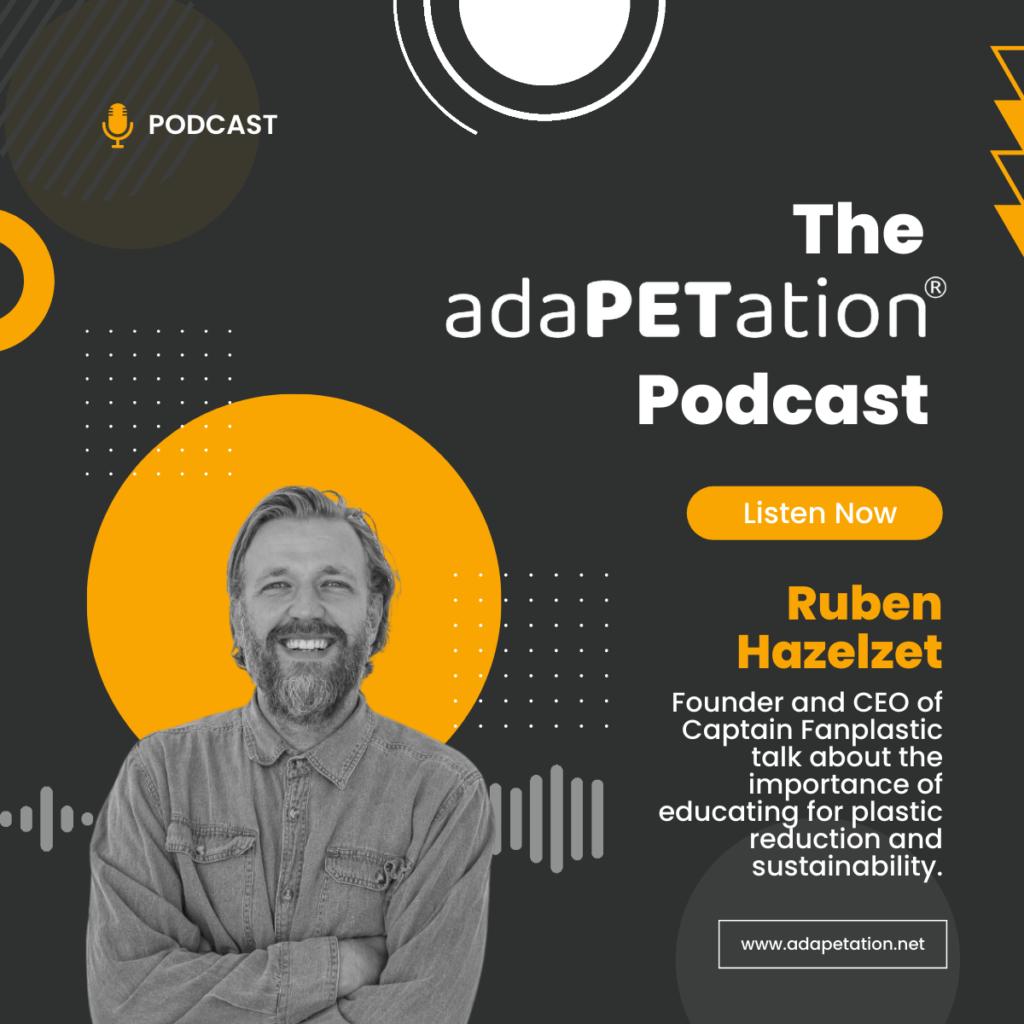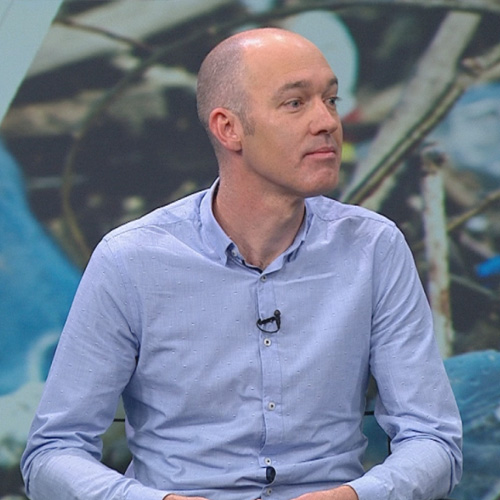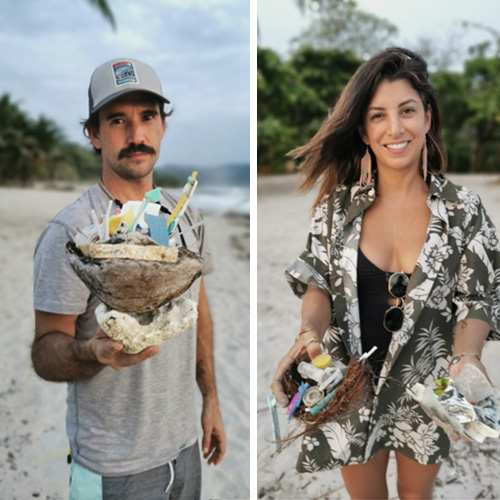
Meet Captain Fanplastic, a pirate that teaches kids to treasure plastic with a fun program that educates on the importance of plastic reduction and sustainability.

The adaPETation® Network has returned to Africa —home to our PET Hero 2023— for our first nominee for this year’s prize, the fantastic plastic pirate, Captain Fanplastic.
Captain Fanplastic is a program that educates children on the importance of plastic reduction and sustainability. It is already active in 11 countries across Africa and reached 20,000 kids in 2022.
The project was created by founder, Ruben Hazelzet, in response to the plastic pollution he experienced in the stunning natural setting of South Africa after moving from the Netherlands to Cape Town.
His desire to do something to close the loop on plastic waste resulted in a program that would engage children in a fun and exciting way, a search for a hero to teach them the inherent value of the material and to manage plastic waste better.
The program is centered around the character Captain Fanplastic, a friendly pirate who encourages children to treat plastic as treasure.
Focused on the four “arrrrghs”, the aim of Captain Fanplastic is to change the relationship that children have with plastic so they reduce their consumption and seek ways to avoid it making its way into the environment.
Five Minutes with Captain Fanplastic, a.k.a Ruben Hazelzet
Share with us the light bulb moment for Captain Fanplastic. How did you come up with the original concept?
There are three moments that I’ll try to abbreviate as much as possible. Basically, moment one, I guess, was moving to South Africa and being exposed to its incredible nature, but also seeing its challenge with plastic pollution and, you know, loving the ocean, loving the mountains, but then seeing how pollution is affecting it made me want to do something about it. That was, I think, point number one.
Point two was that I was asked during the Volvo Ocean race stop in Cape Town too. Do behavioral design workshops with some students who created this beautiful plastic turtle interactive turtle from bottles.
The thing was that these students were very shy, so I wanted to help them promote this beautiful turtle so that more people would see it and engage with it. So I dressed up like a plastic captain in a way. And then while I was promoting and getting into this role, I was like, Oh, the name Captain fanplastic actually has a nice ring to it. I knew that I wanted to do something around that problem.
And then actually, a little neighbor kid came up to me and he asked me, “Can I tell you a joke?” And I was like, Yeah, sure. He’s like five. He’s like, “Why are pirates called pirates?”
I’m like, “I don’t know”. And he’s like, “Well,” he’s covering one of his eyes, “because they arrrrgh”.
And obviously it’s a silly joke, but I enjoyed it. And then I was like, okay, plastic pollution captain from plastic pirates, why don’t we reinvent pirates that don’t seek gold but seek plastic treasure?
Because plastic has so much actual value to it, people don’t realize it and why don’t we get this thinking around it? That plastic when you don’t throw plastic on the ground because it’s actually valuable and you should try to get the longest lifetime out of it.
And if you see it laying on the ground, treat it as if you are finding a treasure and put it in your treasure chest. And then I started building the whole program and the behavioral design around it. So there are three lightbulb moments, I would say.
What is it in particular about plastic pollution that moved you to create Captain Fanplastic?
When developing these kinds of behavioral change projects, I look at things that I really want to change or that touch me in a certain way. I guess that South Africa gave me so much so much on the nature side of things.
Coming from the Netherlands it’s a beautiful country but you can’t experience the immensity of nature as you can in South Africa. Seeing that plastic pollution was forming a danger for that or was endangering this beauty I really wanted to change that. In our research to develop this program we attended a lot of beach cleanups and what struck me was that they were, what’s the word? Not very exciting. So I thought why can’t this be like a really exciting, gamified thing that we’re doing besides just picking up plastic and taking a selfie and then showing the world that you’re doing good, which is nothing wrong with but I think there was room for more excitement.
What most struck me at those cleanups was that you only saw, to be honest, mostly middle aged women that were already connected to an NGO or to a project cleaning up in communities that were being challenged by plastic pollution and nobody from the community was there.
So the reason for that is obviously that plastic pollution and thinking sustainably and doing conscious or like applying conscious behavior is quite a luxury in a way and seeing that I thought about how environmental education is still valuable and important to any person. “So how do I get that there?” and that was through creating a school program focusing on the children so that at least they would, build a different relationship with plastic and I mean, I guess the core thing is that I love animals and I love nature and it hurts me to see that plastic is harming them in many ways.
How can design and in particular what you’re focused on, behavioral design help us transition to a better world?
It is so important. It starts by telling an inspiring story, right? You see, now with the whole climate change that people are kind of numb with the messaging around it. Behavioral design is such a powerful tool to understand what things can trigger positive behavior. And then from that, from your research, then build your strategy and in the end, do your creative process around it and guess what we realized was we can keep on cleaning up the world. We also have our friends at the Dutch company Ocean Cleanup, they do good work but we need to change the behavior so that at one point, hopefully we don’t have to clean up anymore.
And that’s our core idea is that if we change the relationship of these children at a young age with plastic so that they, first of all, don’t pollute, don’t litter, and then second, reduce their consumption and manage their plastic better, then we will see a society where there’s no litter anymore.
People try to extend the life value of certain plastics, but also understand which plastics not to buy. For me, design is the key. And with that in design, storytelling is the key. Creating stories that create a world where children want to immerse themselves into.
I see the power of behavioral design and storytelling in the fact that if you would now walk up, you would walk out of your door and you would walk on the street and you would walk towards the kids of eight, nine years. You would ask them, “Oh, can you maybe clean up this neighborhood for me?” The kids will probably kick you against your shins and just continue playing but if you tell them a story that sparks their imagination, it’s incredible. The pirate theme is interesting for children all over the world. I was wondering how it would work in the Netherlands versus South Africa or now in Indonesia but there is the mischief of it, we obviously say they’re friendly pirates, but in the mischief of it, there’s something that kids really love.
And then, telling them the legend of Captain Fanplastic, our first book suddenly creates this world where these children want to become pirates and suddenly then when you ask them on the beach, “Why are you here?” They say, “I’m here to save all animals”. Like 80% of the children will say that because they still have that empathy and strong connection with all living beings or animals or organisms. So then suddenly these kids in 45 minutes will clean an area for you because they’re so engaged and excited. So then behavioral design comes to make that behavior durable or sustainable because we go into the classroom, we do this whole exciting thing but then when you leave, there can be a chance that people slide back into their status quo, something like a common thing within behavioral design.
So you need to start to think about certain nudges that inspire the behavior to continue and give them the tools to showcase the behavior. So, we created recycling bins that look like treasure chests so that when the child walks on the quad, they’re like, “wait a second, I’m still a little pirate from Captain Fanplastic and I’m going to pick this up and I’ll put it in my treasure chest”. So it goes a long way, right? But behavior is always based on raising motivation. And we do that through storytelling and gamification. But then also increasing the ability by giving them tools to manage plastic better and then behavior can sustain itself for the long run.
So how are you approaching the problem of plastic waste? Could you describe how it works. What does Captain Fanplastic actually do? And how have you been able to measure the impact and consequences of what you’ve been doing?
I can highly recommend to anybody to watch the movie Liyana. It’s from South African filmmakers who grew up in Swaziland and created a movie in homage to the country where they were born. Their storytelling is amazing and the children were very much involved in it. And I love that idea so much that when we knew that we wanted to create Captain Fanplastic and a pirate, we basically went into several townships like Khayelitsha, the biggest township in Cape Town, to understand what children of our age group between let’s say 6 to 10 knew about plastic, about plastic pollution, about recycling, and all the things that are connected to it. But secondly we basically designed together with them how Captain Fanplastic should look like, which animals we should integrate into our story. So they created a collage of how their captain should look like and then based on that feedback from the children, our graphic designers then started transforming it into Captain Fanplastic as he is now. The children were very much involved. And then what we do a lot is we do a lot of behavioral tests because that’s the biggest challenge with doing an education program. A big corporate will ask, “What is the hard data of your impact?” Unfortunately, we don’t have the funds to track every child that we engage with, but we test their attitudes towards plastic pollution pre-program and post-program. We test their feelings towards littering and how they dispose of plastic. Based on the behavioral change in their attitudes, we assume that children consume 15% less plastic in their lives. We calculate our impact based on this assumption. We are operating in 11 countries in the world and have reached an average of 20,000 children per year. We are now scaling up tremendously since we started to license other NGOs to facilitate the program.
What would you say are the obstacles or challenges that you currently face in being able to kind of scale your impact or offer your solution at scale?
The licensing system really works. Like I said, I’m now in Madagascar and I saw today Malagasy facilitators showcase the program in this little school in Antananarivo and they do it brilliantly, they engage the children in such a beautiful way. So I guess like getting to schools and bringing the environmental education there is very much doable but we really want to go a step further and by making the school in the sense of placing the school in the centre of waste management in under-resourced communities. So the technology is there now you can turn like non-recyclables into really high quality building bricks and like, the great plastic bake off makes like high end furniture and stuff like that so there is now all the technology to really like take all the tragic plastic in the world, solve the plastic problem and solve, for example, the housing problem.
The technology is there, but like the legislation around it is still not like it’s not yet up to speed, I would say. And what we really are trying to do is that once our learners have heard about the story, we want to install like bins and get recycling going and get to a point even where the school gets gets funds back for their recyclables and non-recyclables so that you get to work with these things called a trash for cash or a trash for food model.
In South Africa we are piloting programs where the school is challenged to get specific types of materials and then they get funds for it in return. And that then is invested into the school feeding scheme or in the development of, for example, vegetable gardens to enrich the, the, the diet of the children.
The challenge I guess is to build a strong chain around it, right? So you need to have your school, then you need to have your collection partners. Often you need separate partners for one partner for recyclables and then one partner for non recyclables. And then you hope that the organic waste the school can do through, you know, like bokashi or worm farms or just composting. So that’s already a couple of players. And then from that you need a funder, right or buyer. So the materials that are taken from the school so that money can flow back in. So you want to create the circular model, but it is not always so easy in every context to build that right. And in Madagascar, for instance, there is no waste management at all. There’s no recycling so then it’s so hard to teach children something. And then they don’t have the tools, right? The famous quote “you can teach somebody how to fish, but if he doesn’t have a rod, like why would you even bother?”
So I guess in my personal challenge I really want to create these circular models at schools but that’s not possible in every environment or community. Although the technology and the opportunities around it are there, people in some places don’t realize that plastic is really treasure. I mean, even in our energy crisis now in Europe, well, in the world, like, you know, you can extract from plastic oil again, in essence money is laying on the streets, but sometimes the technology or the systems are not in place to make that happen.
Where do you find your inspiration? Have you explored biomimicry or systems thinking?
On the storytelling and the power of storytelling, I can really highly recommend that movie. Liyana. I guess I’m drawing my inspiration from the innovations that are happening in the world. That you can see there’s this new technology now like how can it work in our context and how can it like add to our program? But in a way if you look at nature itself and how we want our children to understand that they are a part of this connected living system and that they have a role to play. It’s the same with the schools, with the circular model, like in nature, there’s obviously such great systems happening where, you know, it all balances out that the circle of life in essence, how everything is connected. We want to implement that also into our schools and especially into the waste problem because it can really go into creating opportunities for jobs and solving really serious problems like with these innovations like the great plastic bakeoff have, they have like two cargo containers that you can place in a community for a month then the whole community brings all their plastic waste and you turn it into bricks and now they can go from shacks to like bricked houses. I guess for me it’s very inspirational that there’s so much innovation happening around it and that people get way, way more clever in how we can upcycle these items into something valuable again. Something that is for us treasure.
How do we sustain networks of hope?
You know what something I really learned in my own journey, moving to South Africa really helped me realize that I felt in the Netherlands I became very disconnected from nature. It’s hard to kind of find nature and to connect with it and then suddenly you’re in southern Africa and you’re, for example, in the Sossusvlei or in Death Valley in Namibia and you suddenly realize that you are a very tiny particle in this really big world, right? But that tiny little particle can make a change and I think that what I really see with the learners or the children that we work with is that what is so incredible is that when you are young kids, every kid will have empathy and will have love for nature and for living beings, it can be plants, it can be animals, it can be humans. Every kid has that. And while we grow up, we slowly detach ourselves from that or disconnect from it. Not everybody, but on average so especially working with these children and bringing this type of environmental education to hone in on that empathy and caring for your environment
We teach them that they can all make a change, although they’re very small. They understand that they are part of this bigger thing and if they do a tiny thing and they spread it to their parents, you know, you can get this multiplier effect going and you basically raise generations that look at the world in a different way and when we do the school program you see these children and you see that. They care so much about it, right, that it’s so inspirational. So I guess for me, it’s not really hard to be optimistic because I see that if you empower children in the right way and you also give them the tools that can hopefully lead into the community also in a bigger scale, then you can really you can really have an impact and we can really deal with this problem. So it’s all about, I guess, raising this new generation that also inspires the older generations and remains in love with the beauty that is around us that we sometimes fail to see.
Thank you so much, Ruben. One final question. What would you do with €10,000 of non-dilutive funding if you were to win the PET Heroes 2024 prize?
There are two kinds of innovations that I really want to do. So one is that I would love to develop these 360 videos with Zandile Ndhlovu and create educational underwater videos with these magical virtual reality goggles so the children can access it through that. The other thing is that I’d like to measure the impact even better through our books but also our e-learning, to develop an app that allows pirates all over the world to record what plastic they find and go on treasure hunts together so that we can see how much plastic is collected, what types of plastic are found, maybe what brands are found most so that’s on the innovation part. And then on the other side is, like I said, I would love to go to Latin America or to open up even like a country like Bangladesh, right? I would love to go there and bring this type of education there. So the prize money would help us to find a local implementation partner and adjust our materials and localize it and translate it to the local context and then empower an NGO to go out there and do the work at schools in their community. So I guess there are numerous things but those are the things that I would love to work on, especially in the coming months slash year.
VOTE COMING SOON
The PET Heroes Prize 2024 winner will be chosen through voting starting in March of next year. Stay connected to our social networks for the announcement.
NOMINATE YOUR PET HERO
Tell us what you think of our list of PET Heroes 2024 and recommend inspirational leaders coming up with the best solutions to systemic issues surrounding plastic.
Share it
Useful Links
THE HISTORY OF PLASTIC
Throughout the history of plastic, PET has been crucial in keeping food fresh with lightweight and durable packaging solutions that have helped reduce food waste for almost a century. Learn all about the invention of plastic and the important role it has played feeding people and saving the lives of humans and elephants in the adaPETation® timeline of the history of plastic.





